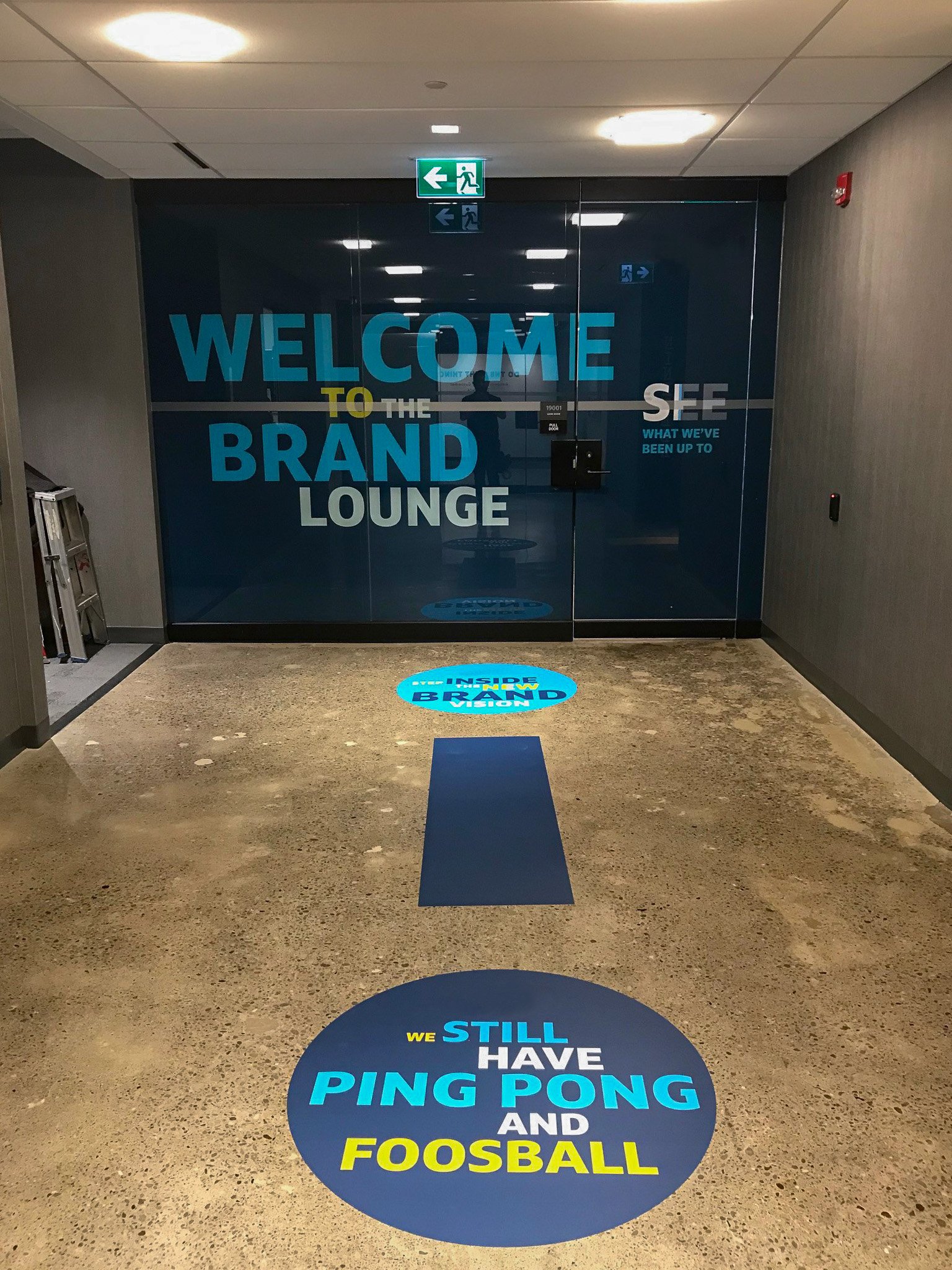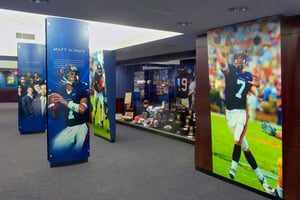Windows are a crucial element in any building, providing both visibility and security. In this...
The Benefits of Floor Graphics
.jpg?width=920&height=613&name=Traffic%20Graffic%20-%20Happy%20Hour%20Floor%20Graphics%20(1).jpg)
Ever get lost in IKEA? You're not alone. The furniture retailer's famously confusing showroom layouts are actually intentional. IKEA wants shoppers to stay in the store longer, so they're more likely to impulse-buy items.
In fact, the company's maze-like design is so effective that it's even been the subject of fake news stories.
In 2018, a story went viral about a man who was arrested for putting fake directional graphics on the floor of an IKEA store. The story was so believable that it was picked up by several legitimate news sites and generated over 75,000 comments.
The point of this story and why it spread so fast is, that people seek guidance in unfamiliar places. How many people do think read this story and thought, 'Wow, what a great idea?"
As Print Service Providers, we can sit back and mull over the larger societal implications of this, or we can take advantage of it to provide a profitable solution: Floor Graphics.
Why Floor Graphics?

Floor graphics are a simple, cost-effective, and temporary way to communicate information. They are also easy to install and can be used in a variety of settings, from retail stores to corporate offices.
Here are some of the benefits of using floor graphics:
-
Floor graphics can be used to create a sense of urgency or excitement. For example, a store might use floor graphics to promote a sale or to announce a new product launch.
-
Floor graphics can be used to communicate a variety of information, including directions, promotions, and safety instructions. They are a great way to catch the attention of passersby and can be used to direct traffic or highlight important areas.
-
Floor graphics can be used to create a sense of brand identity. For example, a company might use floor graphics with its logo and colors to create a consistent brand experience
Simple and Cost-Effective

.jpg)
Floor graphics are relatively simple to produce. The process typically involves creating a digital file of the desired graphic, printing the file onto a vinyl or paper substrate, and then applying the graphic to the floor. This process can be done in-house or by a professional printing company.
One example of their simplicity is, a store might use floor graphics to promote a sale or to announce a new product launch. Once the promotion is over or the new product launch is complete, the floor graphics can be easily removed and replaced with new graphics. This allows businesses to keep their signage up-to-date and relevant without having to invest in permanent signage.
-
Floor graphics can be removed without damaging the floor. This makes them a sustainable option for businesses that are looking to reduce their environmental impact.
-
Floor graphics can be removed and replaced by a single person in a matter of minutes. This makes them a quick and easy way to update your signage.
-
Floor graphics can be used to create a variety of effects, such as arrows to direct traffic or mazes to entertain customers. This makes them a versatile option for businesses that want to add a touch of creativity to their signage.
Floor graphics are also relatively inexpensive. The cost of production will vary depending on the size and complexity of the graphic, as well as the type of substrate used. However, floor graphics are generally more affordable than other types of signage, such as murals or billboards.
The cost of floor graphics can be further reduced by using a self-adhesive substrate. This type of substrate does not require any special adhesives or tools to apply, making it a quick and easy option for DIY installation.
Easy to Install

Overall, floor graphics are a relatively easy type of signage to install. Let's get into the benefits of vinyl and overlaminates.
Vinyl:
-
Thicker graphics are easier to handle. This is because they are less likely to tear or crease, which means that they are less likely to be damaged during installation or removal, but this can also make them more difficult to apply.
-
Floors are typically easier to clean using harsher solvents. This is because floors are not as delicate as other surfaces, such as walls or furniture. Harsh solvents can be used to remove dirt, grease, and other contaminants from floors without damaging the surface.
-
The vast majority of floor graphics are installed on some form of stone. This is because stone is a durable and versatile material that can be found in a variety of settings, from retail stores to corporate offices. Stone is also easy to clean and maintain, which makes it a good choice for floor graphics.
Overlaminates:
-
Most overlaminates are UL-410 certified for slip resistance. This means that they have been tested and approved to meet the standards set by UL Solutions for slip resistance. Slip-resistant floor graphics are important in areas where there is a risk of slipping, such as in wet or high-traffic areas.
-
Most overlaminates have a thickness between 3 and 6 mil. This means that they are between 0.003 and 0.006 inches thick. A thicker overlaminate will provide more durability and protection, but it will also be more difficult to apply. A thinner overlaminate will be easier to apply, but it may not be as durable.
-
When paired with a 3-mil vinyl, this combo has rigidity and isn’t likely to crease when handling. This means that the graphic will be less likely to tear or fold when it is being applied. This can make installation easier and less time-consuming.
Here are some tips for installing floor graphics:
- Make sure the surface is clean and dry. Any dirt, grease, or moisture can interfere with the adhesive and cause the graphic to peel or wrinkle.
- Apply the graphic in a well-ventilated area. Some overlaminates emit fumes that can be harmful if inhaled.
- Use a squeegee to remove any air bubbles. Air bubbles can cause the graphic to wrinkle or peel.
- Press the graphic down firmly. This will help to ensure that the adhesive bonds properly.
- Let the graphic dry completely before walking on it. This will prevent the adhesive from being damaged.
Room for Creativity

Floor graphics can be simple and effective, but they can also be creative and eye-catching. The choice of colors, fonts, and graphics can all be used to create a unique and memorable design.
Clear laminates and high-quality media options can be used to add a touch of sophistication to floor graphics. These materials can help to protect the graphics from fading, scratching, and other damage.
Where to Use Floor Graphics

Here are some examples of how businesses can use floor graphics to communicate changing information:
- A grocery store can use floor graphics to promote weekly specials or to announce new products.
- A clothing store can use floor graphics to promote seasonal sales or to highlight new arrivals.
- A museum can use floor graphics to guide visitors through the exhibits or to provide information about the exhibits.
- A hospital can use floor graphics to direct patients to different departments or provide patient safety information.
No matter what your customer's business is, floor graphics can be a great way to communicate changing information to their customers with a creative design.
Overall, floor graphics are a simple, cost-effective, and versatile option for businesses of all sizes. They are a great way to communicate important information and they can be used in a variety of settings. If you are looking for a way to help your customers improve the safety and accessibility of their shop, floor graphics are a great option to consider.




